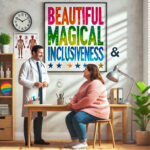Learning from lived experience: rating items for body image questionnaire

Learning from lived experience: rating items for body image questionnaire
People with lived experience of an eating disorder are being called on to help researchers understand and measure core body image disturbance in the illness.
Body image as a concept is much more nuanced than typically considered, and several aspects of body image disturbance could contribute to eating disorder onset and maintenance. Body dissatisfaction is commonly investigated in the context of eating disorders (Stice and Shaw, 2002), but this aspect of one’s body image is becoming very prevalent and even normalized in Western societies (Mond et al., 2013), so it alone cannot be a very specific indicator of a potential eating disorder.
Unfortunately, little is known about unique roles other body image aspects play at each stage of eating disorder trajectory. In order to start better understanding how aspects of body image interact with eating disorder symptomatology, and each other, we need to first be able to assess them reliably and accurately as possible.
There are several self-report questionnaires—or at least subscales within questionnaires—for certain aspects of body image (Garner et al., 1983; Piran et al., 2020), such as dissatisfaction with weight/shape, internalization of ideal bodies, embodiment, and so on. However, researchers are sometimes compelled to rely on extracting responses from single questions (items) of a questionnaire. For example, experiencing fear of gaining weight and thinking about weight/shape so that concentration for other things is impaired are two aspects of one’s body image that are currently assessed using just one item. In case of overvaluation of weight/shape (placing undue importance on one’s body weight/shape when judging oneself as a person), two items are averaged to create a composite score representing this concept. Overall, these practices are questionable from psychometric perspective since one or two items may not be reliable and valid indicators of potentially complex psychological phenomena.
It is also crucial to develop assessment tools for male body image disturbance, which in some cases can vastly differ from experiences of females in eating disorders. For instance, males more often than females experience concerns with being “too small” or “too scrawny” and have a desire to gain muscles, which is often overlooked as a symptom of eating disorders. Regrettably, current diagnostic system and assessment tools reflect the female-centric nature of the eating disorder and body image field, thereby leading to symptomatology being undetected in males.
Multidimensional questionnaire
For these reasons, the field of eating disorders will benefit from development of a multidimensional questionnaire for body image, that will assess all important aspects of body image disturbance that play a role in eating disorder onset, maintenance, and exacerbation. This is the main aim of my PhD project.
In the first part of this project, I conducted interviews with people who have eating disorder lived experience, with efforts to recruit a somewhat diverse sample (females andmales, different eating disorder diagnoses, people of different age, living in different countries, and so on). In the interviews, participants were asked about their body image experiences throughout their eating disorder, but also before and after an eating disorder (if they had recovered). Questionnaire items were extracted from their narratives, and later rated by field experts (clinicians and researchers).
Before finalizing the questionnaire, input from people with lived experience will help to ensure that items are clear, well-worded, and that they assess relevant body image experiences. It will also be helpful to have feedback on the response scale (from Never to Always) and used timeframe (in the last 4 weeks/28 days). For this purpose, I am trying to recruit people with eating disorder lived experience (whether they have recovered or not), or those who think they might have an eating disorder but are not formally diagnosed.
As eating disorders in males share similarities with muscle dysmorphia (Badenes-Riberaet al., 2019) in terms of elevated concerns around body shape and size, as well as eating concerns, it is important to also capture opinions of people with muscle dysmorphia.
Participants for this study need to be above 18 years old, with eating disorder/muscle dysmorphia lived experience, regardless of gender, ethnicity, and other characteristics. Participation lasts around 20 minutes and is anonymous. To conclude, participants can choose a charity that will receive a $10 AUD donation. Closing date for this study is around 25 June 2021 (flexible depending on response rate).
To participate in the study, click here.
References
Badenes-Ribera, L., Rubio-Aparicio, M., Sánchez-Meca, J., Fabris, M.A. and Longobardi, C., 2019. The association between muscle dysmorphia and eating disorder symptomatology: A systematic review and meta-analysis. Journal of behavioral addictions, 8 (3), pp.351-371.
Garner, D.M., Olmstead, M.P. and Polivy, J., 1983. Development and validation of a multidimensional eating disorder inventory for anorexia nervosa and bulimia. International journal of eating disorders, 2 (2), pp.15-34.
Mond, J., Mitchison, D., Latner, J., Hay, P., Owen, C. and Rodgers, B., 2013. Quality of life impairment associated with body dissatisfaction in a general population sample of women. BMC Public Health, 13 (1), pp.1-11.
Piran, N., Teall, T.L. and Counsell, A., 2020. The experience of embodiment scale: Development and psychometric evaluation. Body image, 34, pp.117-134.
Stice, E. and Shaw, H.E., 2002. Role of body dissatisfaction in the onset and maintenance of eating pathology: A synthesis of research findings. Journal of psychosomatic research, 53 (5), pp.985-993.





